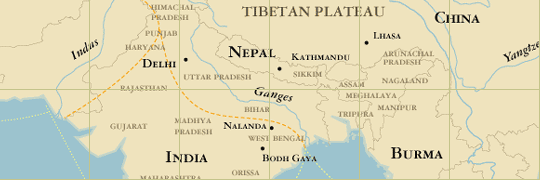 
  
Nepal
Despite its relative inaccessibility, Nepal was long a renowned center of trade. It is known that by the fifth or sixth century B.C.E., Indian traders were regularly making their way to the Kathmandu Valley, which lies across one of the main pathways linking India with Tibet and the ancient east-west trade routes. The southern terminus of this route connects with two of the great Indian trade arteries, the Uttarapatha, which linked India with the Near East, and the Dakshinapatha, which flowed southward. Nepal became a gateway from China and the central Asian cities to the great monastic centers of India. Buddhist monks and teachers traveling the overland route between India and China would usually pass through Lhasa, the Tibetan capital. When it was secure, which was not often, the route through Tibet and the Kathmandu Valley was a preferred north-south highway for merchants and pilgrims alike because it was shorter than the safer land and sea routes that linked the cities and monasteries of northeastern India, the Buddhist homeland, with Chinese urban centers. sea routes that linked the cities and monasteries of northeastern India, the Buddhist homeland, with Chinese urban centers.
The geographic position of Nepal's Kathmandu Valley was likely a crucial factor in its economic and, ultimately, its cultural development. In winter, snow closed the mountain passes leading north to Tibet, and in summer, malaria deterred caravans from using the jungle paths of southern Nepal. Traders therefore found it expedient to cross one or the other as they could, and then pause in Kathmandu to await the onset of a more conducive season before continuing their journey.  In this way, Kathmandu became a vital cultural transfer point. Like the Silk Road cities of western China, Nepalese rulers bolstered their economies by exacting a tax on transactions conducted within their territory; this provided them with abundant wealth for the pursuit of religious and civic works. The Kathmandu Valley became a rich artisanal center patronized by both locals and foreigners, especially those from Tibet, where Nepalese artistic style was particularly popular. In this way, Kathmandu became a vital cultural transfer point. Like the Silk Road cities of western China, Nepalese rulers bolstered their economies by exacting a tax on transactions conducted within their territory; this provided them with abundant wealth for the pursuit of religious and civic works. The Kathmandu Valley became a rich artisanal center patronized by both locals and foreigners, especially those from Tibet, where Nepalese artistic style was particularly popular.
Although it is impossible to give precise dates, it can be assumed that Buddhism was introduced to Nepal at a very early date, at least within a couple of centuries of the Buddha's death, circa 483 B.C.E. It is known that all three types of Buddhism were practiced in the country, although it was Vajrayana Buddhism, which was easily assimilated and open to Hindu influences (Hinduism is today practiced by more Nepalis than Buddhism), that continues to prosper into the present day. The main practitioners of Vajrayana Buddhism in Nepal are the Newars, a predominantly Buddhist ethnic group that is also responsible for producing the majority of Nepal's art. that continues to prosper into the present day. The main practitioners of Vajrayana Buddhism in Nepal are the Newars, a predominantly Buddhist ethnic group that is also responsible for producing the majority of Nepal's art.
Two images of Avalokiteshvara, the Bodhisattva of Compassion (Figs. 1, & 2) were produced in the Kathmandu Valley by its famed Newari metal-workers. Cultural influences brought in on the trade routes explain why these sculptures follow the same basic iconographic principles and artistic norms that prevailed in India and reflect the impact of India's styles of the Gupta period (ca. 4th – 6th century) (Figs. 1 & 3) and Pala period (ca. 8th – 12th century) (Figs. 2 & 4). However, the standing bodhisattvas' plump faces and hawk noses are distinctly Nepali, as is the beautiful reddish color of the metal visible where the gilding has rubbed off, which comes from the high copper content of Nepali bronze.
Back | Next
|
